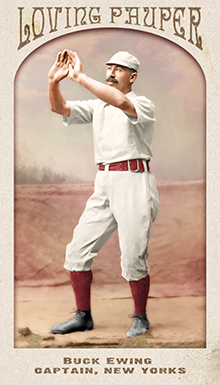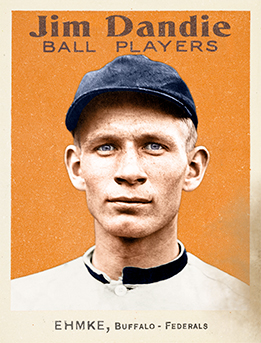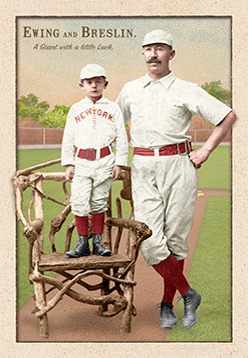
- Series: 1880s: Loving Paupers
- City: New York
- Team: Giants
- League: National League
- Hall: National Baseball Hall of Fame
William Ewing (1859-1906) was the premier catcher of the 19th century, honored for decades after his early death as even, perhaps, the greatest player of all time. A scourge at bat, Buck hit over .300 ten times. He played behind the plate with courage and style, crouching close to the hitter so as to shave precious seconds off his inerrant throws. Ewing had debuted with the remarkable Troy Trojans in 1880 and joined four future Hall-of-Famers in moving to NYC in ‘83. The sturdy catcher may have been the primary inspiration for Jim Mutrie’s “my Giants!” exclamation that led to the new identity of the Gothams. An arm injury on a raw spring day curtailed his tenure behind the plate from 1891 on. Such a magnetic figure couldn’t escape the turmoil of the Players’ League controversies and Ewing was sometimes pilloried for lax effort. Despite such caviling, Ewing left as indelible a mark on the game’s first century as anyone. Upon his induction to Cooperstown (among the first six of the “pre-modern” era), he was hailed by Connie Mack as the greatest catcher he had seen and he had seen most.
- “Buck” was a derivative of “Buckingham,” bestowed on the budding star by an admiring scribe who wanted to add gravitas to the youngster’s reputation
- Played all nine positions and managed 3 different teams over 7 seasons
- Was the first catcher elected to the Hall of Fame; and the second 19th century player elected (after Cap Anson)
- Elected to Hall of Fame: 1939
Auction History
Cartophilia
Old Judge Pose: 149-5

- Series: 1888 Champion New York Giants
- City: New York
- Team: Giants
- League: National League
- Hall: National Baseball Hall of Fame
William Ewing (1859-1906) was the premier catcher of the 19th century, honored for decades after his early death as even, perhaps, the greatest player of all time. A scourge at bat, Buck hit over .300 ten times. He played behind the plate with courage and style, crouching close to the hitter so as to shave precious seconds off his inerrant throws. Ewing had debuted with the remarkable Troy Trojans in 1880 and joined four future Hall-of-Famers in moving to NYC in ‘83. The sturdy catcher may have been the primary inspiration for Jim Mutrie’s “my Giants!” exclamation that led to the new identity of the Gothams. An arm injury on a raw spring day curtailed his tenure behind the plate from 1891 on. Such a magnetic figure couldn’t escape the turmoil of the Players’ League controversies and Ewing was sometimes pilloried for lax effort. Despite such caviling, Ewing left as indelible a mark on the game’s first century as anyone. Upon his induction to Cooperstown (among the first six of the “pre-modern” era), he was hailed by Connie Mack as the greatest catcher he had seen and he had seen most.
- “Buck” was a derivative of “Buckingham,” bestowed on the budding star by an admiring scribe who wanted to add gravitas to the youngster’s reputation
- Played all nine positions and managed 3 different teams over 7 seasons
- Was the first catcher elected to the Hall of Fame; and the second 19th century player elected (after Cap Anson)
- Elected to Hall of Fame: 1939

- Series: Jim Dandie Feds
- City: Indianapolis
- Team: Hoosiers (FL)
- League: Federal League
James Joseph Esmond (1889-1948) played shortstop for three major league clubs from 1911-1915, half of his tenure being with two Federal League teams: the Indianapolis Hoosiers and Newark Pepper. Jimmy had started in pro ball with the Gloversville-Johnstown/Elmira nine of the New York State League in 1908, a team with constituents all over the upstate area that would be reconstituted from 1939-51 in the Canadian-American League. Esmond never managed much offensive output in the minors and may have been that rare player to perform better when he got to the Cincinnati Reds in 1911 and hit .273. He reverted to form in '12, taking a demotion to the International League's Montreal team in 1913 before getting a final chance at major league glory in the renegade Federal League. He would be out of baseball for all of his late twenties before reappearing with Syracuse of the IL in 1921 at age 31. He then moved to the Eastern League and played a season each for Waterbury, Albany and Pittsfield. Jimmy's performance in Indiana and New Jersey far exceeded his norm, undoubtedly due to the paucity of truly major league caliber talent as the Feds tried valiantly to compete as a third league. He hit .295 for the Hoosiers with a league-leading 15 triples. Though his batting average subsided with the Peps he hit 11 more three-baggers showing extra-base prowess heretofore not in evidence. Esmond's debut in Newark allowed him to bask in the glow described in the local paper: “Newark and its surrounding hamlets were seized with a violent attack of baseball yesterday, accompanied by a high fever and laryngitis. The ailment can be directly traced to the opening of the Newark Federals at their new, roomy park in Harrison. The epidemic spread among nearly 25,000 Jersey folk who jammed the new park to see 'Whoa Bill' Phillip's 'Peps' make their home debut against Otto Knabe's Baltimore Terrapins.” The celebration was dampened a bit by the Terps' 6-2 victory. Sadly, Jimmy's three errors made it tough for starter Cy Falkenberg.
- Esmond's major league debut in Cincinnati was in the ballpark known as the Palace of the Fans, occupied by the franchise since 1902. In 1912 Jimmy and the Reds got to inaugurate Crosley Field, the team's home until 1970

- Series: Jim Dandie Feds
- City: Buffalo
- Team: Blues (FL)
- League: Federal League
Howard Jonathan Ehmke (1894-1959) was a durable pitcher who played fifteen of his sixteen years in pro ball in the majors. The right-hander compiled a 166-166 record, debuting with the Buffalo Blues of the Federal League in 1915 before moving on to a fine career with three of the sport's great teams: the Tigers, Red Sox and Athletics. Ehmke had an unlikely highlight to his long career in 1929's World Series when Connie Mack took him up on his offer to pitch the opening game. Howard had shown flashes of greatness including hurling a no-hitter followed by a one-hitter and had pitched very respectably in '29, going 7-2. Nevertheless, he was a surprise choice to start the series as the veteran's activity had been limited that season. But the savvy Mack knew the opposing Cubs might be vulnerable to a side-arming righty. Ehmke went on to set the record for strikeouts in the post-season with 13, a record that would stand for decades until surpassed by Carl Erskine in 1953, a feat Howard listened to on his car radio until the battery died. He also set a record that held until 2006 for having the fewest regular-season wins by a Series starter.
- Bill James has called Connie Mack's decision to start Ehmke in '29 “the most brilliant managerial stratagem in the history of baseball”
- Playing for Boston in 1923, Ehmke won 20 and threw his no-hitter against Mack's Athletics, followed four days later by a one-hitter versus the Yankees, an effort marred only by a grounder off the third baseman's chest ruled a hit. Things evened out for Howard, however, as his no-no had featured a hit off the wall that became an out when the batter missed first base
- Thanks to his no-no followed by the one-hitter, Ehmke still holds the American League record for fewest hits allowed in back-to-back starts with 1
- Ehmke had a distinguished career as a player but also made his mark with his inventive bent. He sold the Pirates on his idea for a tarpaulin to cover Forbes Field's infield in the event of rain. Howard parlayed that sale into a life-long business marketing all manner of tarps and fabrics, including canvas for the war effort in the forties. The Ehmke Manufacturing Co, based in Philadelphia, continues to this day

- Series: 1880s: Diamond Duos
- City: New York
- Team: Giants
- League: National League
- Hall: National Baseball Hall of Fame
Buck Ewing:
William Ewing (1859-1906) was the premier catcher of the 19th century, honored for decades after his early death as even, perhaps, the greatest player of all time. A scourge at bat, Buck hit over .300 ten times. He played behind the plate with courage and style, crouching close to the hitter so as to shave precious seconds off his inerrant throws. Ewing had debuted with the remarkable Troy Trojans in 1880 and joined four future Hall-of-Famers in moving to NYC in ‘83. The sturdy catcher may have been the primary inspiration for Jim Mutrie’s “my Giants!” exclamation that led to the new identity of the Gothams. An arm injury on a raw spring day curtailed his tenure behind the plate from 1891 on. Such a magnetic figure couldn’t escape the turmoil of the Players’ League controversies and Ewing was sometimes pilloried for lax effort. Despite such caviling, Ewing left as indelible a mark on the game’s first century as anyone. Upon his induction to Cooperstown (among the first six of the “pre-modern” era), he was hailed by Connie Mack as the greatest catcher he had seen and he had seen most.
- “Buck” was a derivative of “Buckingham,” bestowed on the budding star by an admiring scribe who wanted to add gravitas to the youngster’s reputation
- Played all nine positions and managed 3 different teams over 7 seasons
- Was the first catcher elected to the Hall of Fame; and the second 19th century player elected (after Cap Anson)
- Elected to Hall of Fame: 1939
Willie Breslin:
Master William Breslin was one in a line of NY Giants’ mascots in the 1880s, primarily due to HOF catcher Buck Ewing’s love of “hoodoos.” Superstition is still alive and well in baseball and goes back to its roots. In the old days it wasn’t rally monkeys, tomahawks or Phanatics–it was young boys recruited from the mean streets by ball players desperate for an edge. Lads such as “masters” Betsie and Preston prowled the NY dugout in 1886, preceded by an unknown “colored boy” that year. Any charm could do, though. Ewing seized on a yellow mutt, a ring-tailed monkey named “Mose,” or a toy barking dog. But no mascot seems to have gained the popularity and fame of Willie Breslin. He wasn’t the first to be given an Old Judge card (that was Willie Hahm in 1887), but he is the only one to have his own card as well as a famous pose with Ewing in a photo taken in 1884 and used on the OJ series of 1889. One of Buck’s proteges was Fred Boldt, a Chicago waif the team picked up on the road. Back in NY, young Fred ran up an account at a diner near the Polo Grounds and absconded with Cannonball Titcomb’s shoes.
- The Breslin Old Judge cards have become highly prized
- Sadly, biographical data for Willie and his cohorts is lacking. We trust he turned out better than young Boldt
Auction History
Cartophilia
Old Judge Pose: 149-11




